writing|existential angst|parenthood|anxiety PatreonKo-Fi
Don't wanna be here? Send us removal request.
Photo

“Jewels” performed by Staatsballett Berlin
© Carlos Quezada
1K notes
·
View notes
Photo

Swan Lake (Mariinsky Ballet, 2012)
450 notes
·
View notes
Photo
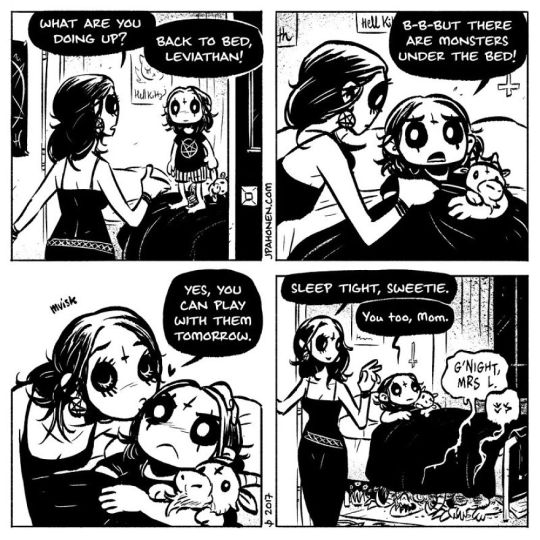
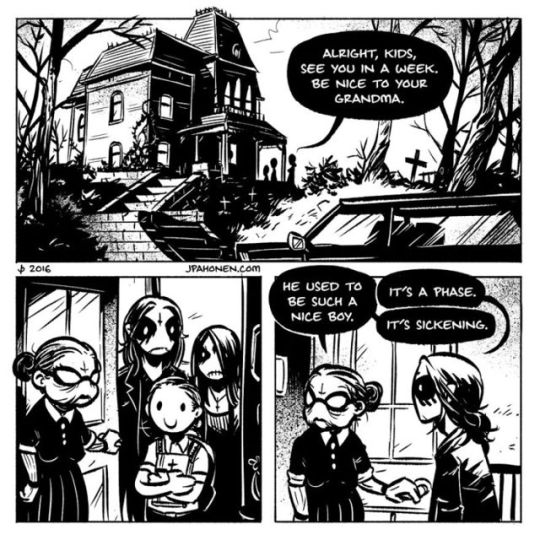
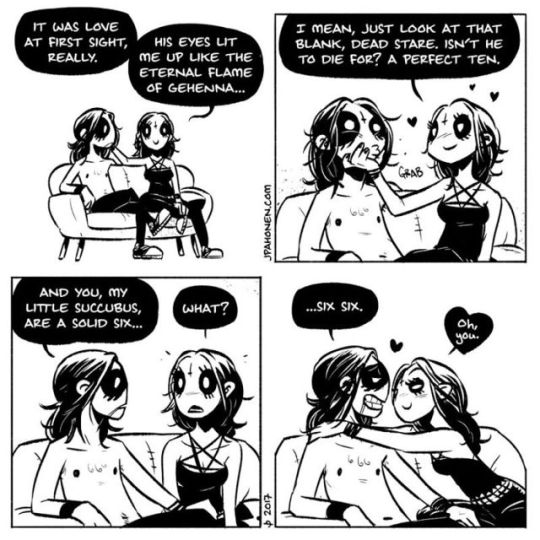

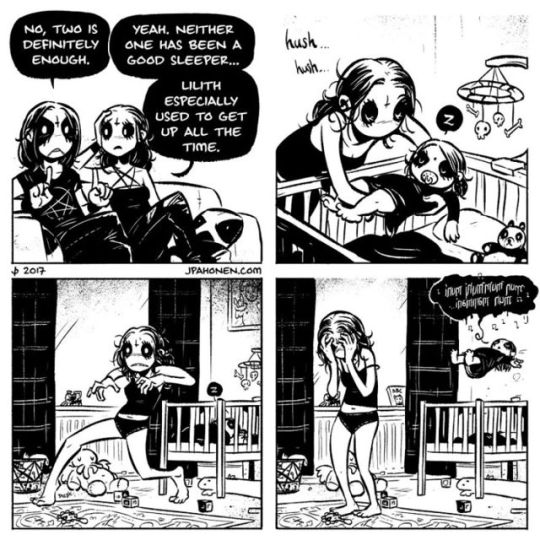
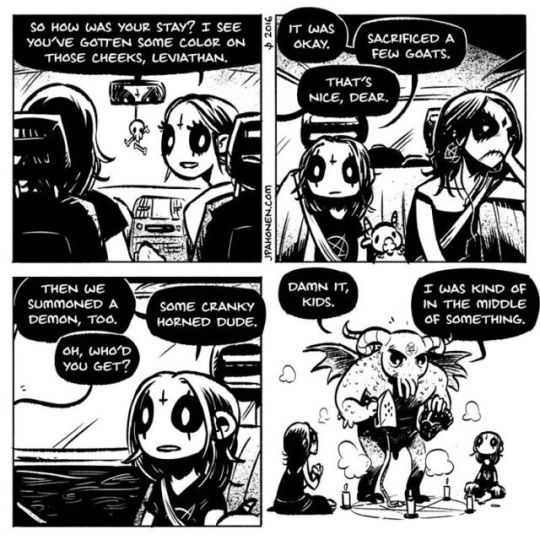
Created by Finnish artist JP Ahonen, the Belzebubs comic strip features an adorable metal-loving family and all of their dark adventures together. From having a little baby to having lunch with grandma - the strip features normal everyday things a family would do, but in a strangely adorable black metal way.
89K notes
·
View notes
Photo

Bad Ass Bitches . Manananggal
Artwork by Meredith McClaren
Also! I have a Kickstarter going for a new art book ;)
671 notes
·
View notes
Text
Either explain it or don’t.
When authors include things that don’t fit within the real world–magic, time travel, anachronisms–there is an impulse to explain how it works. Which can be fantastic for worldbuilding, but if you don’t know what you’re talking about, it can make more problems than it solves.
Stephenie Meyer tried to explain some bizarre thing about chromosomes, and it made the biology of vampires and werewolves make no sense. Suspending disbelief worked better in that case before she tried to ground it in the real world.
Lemony Snicket, on the other hand, just has random anachronisms that are never explained, but because there’s nothing even close to resembling an attempt at an explanation, we can just shrug and go, okay, that’s how it works. The magic in Harry Potter seems to basically not be grounded in anything, but we can believe it within the context of the story because she doesn’t try to ground it in anything.
In Jim Butcher’s Codex Alera, on the other hand, he goes into a lot of magic theory, and it gives us a strong feeling of worldbuilding. There’s enough logically coherent explanation for it to feel grounded within itself.
It is possible to go too far (see: Orson Scott Card’s Xenocide and Children of the Mind) where the plot ends up so tied in the reader understanding intricately detailed scientific and pseudo-scientific minutiae that the story is incomprehensible without it.
Generally, though, if you’re going to make something up, either say it exists and leave it at that, or entirely figure out how it works. Halfway is always less believable than nothing at all.
30K notes
·
View notes
Photo

Bad Ass B . Acheri
(I don’t feel comfortable calling them bitches since they are child ghosts. But they’ll still waste you if you test them.)
Artwork by Meredith McClaren
174 notes
·
View notes
Text
The Structure of an Injury Plot
The Structure of an Injury Plot

An injury plot works on one very simple three-part platform:
A character gets hurt. (The Beginning)
That character gets treatment and begins to feel better, but must navigate the world in a state of partial disability. (The Middle)
Finally, the character settles into their new normal, whether that’s back to a healthy baseline, living with some partial disability, or suffering a total disability of one body part or another. (The End)
Congratulations! This book is done. Go forth and maim your characters!
If only…
The good news is that sticking to this simple structure will give you a perfectly reasonable injury tale. Observe:
While daydreaming about smashing a homer at the company softball game, Mary trips over the ottoman, falls, and breaks her wrist. She tries icing her wrist, but the pain just keeps getting worse. (The Beginning)
She goes to the ER and gets X-rays and a cast. Thoughts of the game are replaced with daily challenges: how to button her shirts, how to drive her stick shift, how to type her TPS reports at work. She solves these challenges by asking her wife for help with her shirt, swapping cars for a couple of weeks with a coworker who has an automatic, and using dictation software. (The Middle)
Eventually, Mary’s cast comes off. Her wrist still hurts when the weather changes, but mostly she can ignore it. The softball game is all but forgotten. (The End)
This progression certainly works, although it’s a little dull and, most importantly, it lacks meaning. At present, it’s a plot, but not really a story. Remember, Mary needs to change in some fundamental way for it to be a story with meaning (rather than a series of things that happen).
One way we could add some meaning is defining why the softball game is so important to her. Does she need to redeem herself for a mistake? Does she miss the glory days of her youth? Is she trying to impress her boss – or a potential side lover? (Scandal Alert! Or, a perfectly healthy polyamorous relationship.)
In short: this plot is good, or at least makes sense, but now let’s elevate this plot to the level of story.
In my experience, this is where most injury plots fall apart. There’s a very clear cause – a character is injured, usually shot – but there’s no effect on the person or on the story. It becomes simply a piece of texture, an element of “grit” that carries no weight of meaning behind it.
(If texture is something you’re interested in for your story – if you want the injury for the sake of having an injury, not as a mirror to hold up to your character – that’s okay too, as long as the injury is fairly minor. We’ll get to this in Part 8: Sweating the Small Stuff.)
So we’ve taken a look at the Beginning, Middle, and End of Mary’s broken wrist plot, and touched on why this might matter to her. All of which is great! But let’s break down those three components into smaller pieces that will help us understand the particular quirks of an injury plot.
There are six distinct phases of the injury portion of the injury plot.
Broken down by plot section, these are:
The Beginning
The Inciting Injury: the moment and manner in which the character gets hurt.
The Immediate Treatment: what the character does in the moment to feel better and avoid further injury.
The Middle
The Definitive Treatment: when the character receives care which ultimately begins their healing process.
The Rocky Road to Recovery: when the character faces challenges relating to their new disability and how they cope with those problems during healing.
The End
The Big Test: the moment when a character must overcome a greater challenge related to the global plot – while still recovering from their injury.
The New Normal: when your character’s final degree of disability becomes apparent. They can have No Disability, a Partial Disability, or be Totally Disabled (for the affected body part).
You can see places where the five fundamental elements of storytelling mesh into the injury plot. The Inciting Injury is the Inciting Incident, the Progressive Complications are in the Treatment stages and the Rocky Road to Recovery, the Crisis and Climax parallel nicely with the Big Test, and the Resolution is one and the same as the New Normal.
So why the relabeling? Because it’s easy to get distracted by vague terms. The labels that are injury-specific will help you remember the pieces you need to have in place in order to make sure your audiences find your arc believable.
Let’s take another look at Mary’s wrist fracture, through the lens of the Six Phases:
Inciting Injury: Mary trips over the ottoman and breaks her wrist.
Immediate Treatment: Mary tries to ice her wrist and hopes it gets better, but it doesn’t.
Definitive Treatment: Mary goes to the ER, gets X-rays and a cast.
The Rocky Road to Recovery: Mary’s everyday life becomes more challenging with her broken wrist! Driving a stick shift is out, she can’t even button her own shirt, and she can’t effectively type one-handed. She solves each of these problems.
Big Test: Mary doesn’t have one… yet.
New Normal: Eventually Mary’s cast comes off, and she has a very minor Partial Disability: some lingering wrist stiffness and some aching when the weather changes.
Hopefully the first three phases are pretty clear and straightforward. But I want to talk about the Rocky Road to Recovery for a little bit, because, at least at the moment, it’s the easiest way to touch on the third rail of the story: why the injury actually matters.
Why is it, exactly, that these three tasks are so important to Mary? Essentially, what parts of herself does this injury force her to face?
Buttoning Her Shirt: As it stands, this is just an inconvenience, one that will go away in a few weeks. But what if Mary is very independent, and hates anyone – even her wife – seeing her vulnerable and weak? Why would she feel this way? Maybe when she was younger, Mary had to take care of her aging grandmother, and she always hated buttoning her grandmother’s blouse. She always vowed that she would never get to that stage in her life – and yet here she is. Maybe she’s coming up on a birthday and fearing her older age.
(Note that these concepts are both very natural and very ablist. On the one hand, change is extremely hard, especially where it concerns things we take for granted, such as our ability to do anything we choose. On the other hand, the mindset that becoming disabled is an awful thing implies that the lives of disabled people are awful, which doesn’t necessarily follow. Be aware of what you’re writing as you write it!)
Swapping Cars: Again, this is an inconvenience – until we know why it’s a big deal for Mary. Is she super proud of her ability to drive a stick shift? Is she super proud of her car as a status symbol – and now she’s swapping her this-year’s Lexus for her coworker’s twelve-year-old Civic? What if she’s a neat freak, and the person she’s switching cars with is a total slob? Or, what if she just got her car – by inheritance, and she has conversations with her car as though it’s her lost parent?
In any of these cases, why does it matter?
Typing and Work: Why does it matter so much that Mary has difficulty typing? Is she on the verge of losing her job – hence her burning desire to impress at the softball game? Is it her dream job she’s at risk of losing, one she’s fought to get? Does she feel like an imposter, like she’s gotten someplace she doesn’t actually deserve, and maybe losing the job is some cosmic retribution for her masquerade? Or maybe she’s self-conscious about her voice (why? An utterly embarrassing failure at a school talent show when she was a teen?), and doesn’t want to use dictation software where other people can hear – but it’s the only way to keep doing her work?
As you can see, this is the single best place where an injury plot can teach us about Mary. With just three relatively small challenges, we learn about her grandmother’s illness, her connection with her lost parent, and her sense of being an imposter at a job she doesn’t deserve (even if she does). All of a sudden, Mary isn’t just a woman who tripped over an ottoman – she’s a person, with a story. Maybe we even feel like we know her. Maybe we identify with these pieces of her we’ve discovered through her struggle.
The magic of storytelling is that if what happens to the character matters to the character, and we know why that is, then what happens will matter to your audience as well.
In the next few sections, we’re going to break down each part of the injury plot more thoroughly, including the way some stories, great and small, have approached them. I’m also going to give you a rough sketch of a story made especially for this book that will illustrate the way each portion of the injury plot might work.
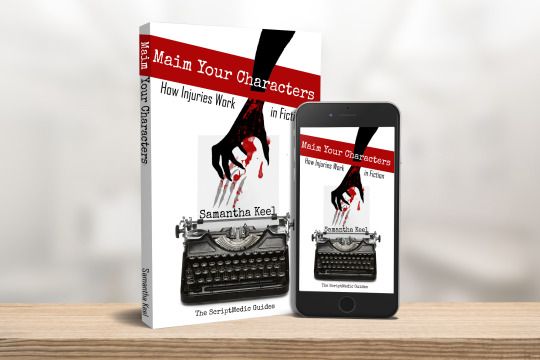
This post is an excerpt from the forthcoming Maim Your Characters, out September 4th, 2017 from Even Keel Press. If you’d like to read a 100-page sample of the book, click here. If you��d like to preorder signed print or digital copies of the book before 9/4/2017, or claim Executive Producer status of the upcoming Blood on the Page, click here.
xoxo, Samantha Keel
The Structure of an Injury Plot was originally published on ScriptMedicBlog.com
1K notes
·
View notes
Text
Tips for Writing Magic
So, as we all know, there are many different kinds of magic — and more being discovered every day as writers create them. It’s true that every world as different and therefore each type of magic created will be different, but following a few of these tips can help you flesh it out just a bit more.
1. Consider your world’s history. Were there ever any major events involving magic or knowledge of it? How has magic proven useful in the past? How much has your culture changed since that time; are its past uses still applicable? Has there been a history of more powerful people having a possession or knowledge of magic?
2. Decide how magic is seen through the eyes of the people. Is it taboo? Dangerous? Helpful? Is it a practice that has to be kept in secret or can it be done anywhere? Are there certain places for it? Consider the people with more knowledge of it: are they seen as wise or dangerous? Are there people with professions dedicated to it?
3. Determine its use in everyday life. Is it used to help complete regular tasks? What about in education? If your world has an education system, what is magic’s importance within it? Are there everyday items that posses magic? Are these items considered benevolent or evil? Can items be enchanted to help around the house, or is magic reserved only for things of major importance?
4. Think about the people using it. Is there a general age range for people using it? If the range is broad, are there common uses for each age group? More than age, is there a general social status of people with access to it? Is there a stereotype that follows these people? Or a wealth level? Or even an appearance?
So, those are all the magic tips I’ve got for you today. If you’d like to see me cover a topic, be sure to drop a message in my ask box; see you next time with another writing post!
9K notes
·
View notes
Note
how does it feel to have auditory processing problems? what do conversations and instructions sound like? is music soothing or painful? my character has problems with auditory processing so his speech skills are disrupted, he can only really follow one person talking to him at once, and usually wear ear protectors, is this realistic? sorry for the loaded question ;; thank you!
Hi there!
Speech that hasn’t been properly processed is often described as heard as though it was in another language. It’s not that you can’t hear it, you can hear the sounds clearly, it just… doesn’t make sense.
Auditory processing difficulties can be more or less important depending on the person, the moment, energy levels, the environment… They can range from not understanding what’s been said at all, to only understanding something very approximative (which often translates into mishearing the words as similar-sounding words, think of a game of telephone of sorts), to understanding the words correctly, but with a delay (conversations such as “could you pass me the salt please?” “what?” “I said, could-” “Oh, yeah, of course” can occur).
As I said, the environment can affect auditory processing: a noisy environment or one with many sound sources will probably be more difficult to understand speech in. Being able to only follow one person talking at once is thus definitely realistic.
I don’t know what you mean by “his speech skills are disrupted”. If your character has severe auditory processing problems, it could be that he’s nonverbal because he can’t replicate sounds he cannot understand. If he can process sounds well enough to make sense of language at least partially, I’m not sure his expressive language would be very affected. If anyone has experience with this, you’re very welcome to weigh in.
Ear protectors would help if your character has hypersensitivity to sound alongside their auditory processing problems, but I don’t think they always coexist: someone hyposensitive to sounds could also have auditory processing issues.
As for music, I’d say it must depend on the person and on the type of music. In my personal experience, I’ve never made a connection between my auditory processing issues and how I experience music, but there could be one. Once again, if followers want to weigh in, input would be appreciated.
Have a few additional suggestions: your character may need subtitles when watching videos (if he lives in a modern setting), and he might be more comfortable with nonverbal forms of communication. He may have learnt to read lips to some extent to supplement what he hears. Phone calls in particular could be very difficult for him.
-Mod Cat
With regards to music, I do find that my enjoyment is impacted by sensory processing. While I can usually enjoy music played quietly, music becomes painfulwhen I am tired and struggle more with auditory processing. I find that music that I don’t know and music that is unpredictable becomes painful first, but even songs that I know well and enjoy become painful when I am tired. It’s almost as if I am listening to a poorly-tuned radio - I can understand if I pay very close attention, but there’s lots of static and noise in the way.
Music can also be disruptive. Your character might not be able to have a conversation if music is playing, so music would be an annoyance in lots of situations (shops and restaurants in particular). Ear protectors can help the character filter out the background noise - it physically stops them from hearing some of the background noise, so the speech isn’t competing with so many other sounds - but I am not aware of this commonly being used, at least not for much of the time.
-Mod Snail
681 notes
·
View notes
Photo









Surreal & Ethereal Digital Illustrations by Veronika Vajdova
With an obsession with watercolors and brushes, 3D animation & visualization student and freelance artist Veronika Vajdova illustrates stunning surreal digital compositions, which mimic the ethereal and soft beauty of a watercolor brushstroke. The glowing and delicate portraits often feature somber woman in a pensive state of mind. Find her work in her Etsy shop.
View similar posts here!
Keep reading
1K notes
·
View notes
Quote
If you are writing any book about the end of the world, what you are really writing about is what’s worth saving about it.
Justin Cronin (via maxkirin)
9K notes
·
View notes
Text
Grief
Year 1:
It’s okay to cry. He was my dad after all. Now he’s all ashes in a jar six feet under. My boyfriend surprises me with roses and almost makes me start crying all over again. I keep the roses on my desk until they die. (They stay there for a little while after that, too. Maybe that says something about my inability to let go of dead things. I try not to psychoanalyze the rotting roses atop my desk too hard.)
Year 2:
Emotions are weird. I miss his sweaty t-shirts and the smell of freshly cut grass after he mows...mowed the lawn. Past tense. Two years. He’s been gone for two goddamn years and there are some days I’m not quite sure I’ll ever get used to it.
Year 3:
I tell myself that I won’t cry this year, then suddenly it’s 4 in the morning and I’m in the bathroom and suddenly it hits me and I’m hunched over my phone sobbing and he’s dead and it feels like the morning I woke up where my mom walked in the room and said “Kelley, are you awake? Your aunt’s here. Your dad just passed away an hour ago.” Why the hell does everything feel so fresh and-
Why doesn’t grief ever seem to get easier to handle?
2 notes
·
View notes
Text
On Three Week Periods and Gender Dysphoria
Sometimes you find yourself listening to male covers of your favorite songs and jamming out to them at 4 in the morning while starting day 21 of your period.
(Yes, you read that right. Day 21.)
Society in general tends to see menstruation as a female thing, which harms multiple groups of queer people who don’t identify with their assigned gender at birth. For me, my ability to menstruate and possession of a uterus along with its corresponding parts means that society has slapped the label of female on me. A label I’ve wholeheartedly rejected, shrugged off like a years old Halloween costume, in favor of one more freeing: Enby. I’m not one or another. I’m simply me. There are days where I’m more masculine than not, and then, there are some days where I’m simply neither.
There’s nothing wrong with any of this, but, society doesn’t make this rejection of superficial labels particularly easy. The notion of babies being assigned gender at birth is accepted in our generation and white, allocishet, Christian American culture. To not have gender reveal parties or not to paint your baby’s nursery pink or blue (predicated on the baby’s genitals, of course) deviates from the norm.
I’m seen as freakish, which only makes balancing my body’s functions and my personal viewpoint of myself harder. I know that I deviate from the norm. I know that I’m considered the abnormal experience. While I should be able to accept myself for who I am, I sometimes can’t even look at myself in the mirror. Seeing the curve under my shirt, the way my bra straps are visible, the pads I carry in my purse. The fact that I even have a purse to begin with. My body and the things I carry with me all code me as a girl when I’m anything but.
It hurts. I just didn’t realize it could hurt just as bad physically as it does mentally.
#personal#gender dysphoria#dysmenorrhea#long periods#menstruation#transmasculine#enby#tw: periods#tw: menstruation
1 note
·
View note
Text
Somehow I find myself writing a few quick words on a cannibal mermaid project before bed?
0 notes
Photo

oakland’s always hiding something interesting.
5 notes
·
View notes
Photo


i just finished this trilogy and fuck man
kell maresh is the guy
147 notes
·
View notes
